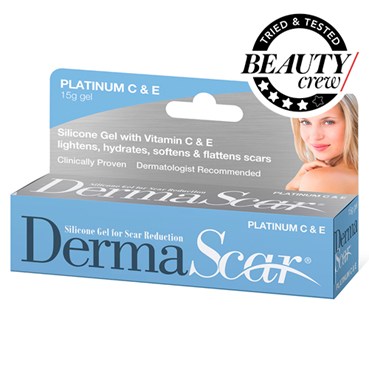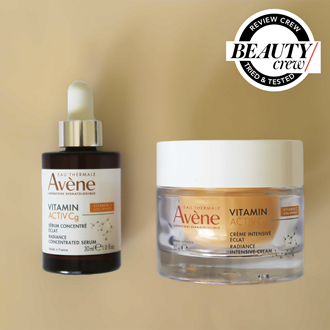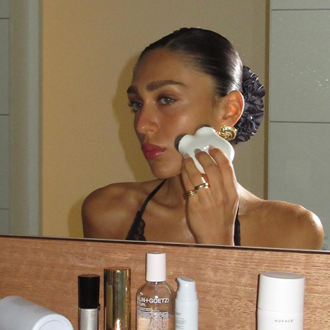Laser or silicone gel: What’s the best way to get rid of scars and stretch marks?

We weigh up each treatment
There’s nothing more empowering than living in a time that encourages us to embrace and celebrate our bodies exactly as they are – flaws and all. We have influential and outspoken celebrities like Chrissy Teigen proudly showing off bruises, pregnancy stretch marks, and cellulite. Ad campaigns are shifting from showing smooth, even bodies to ones that are curvy, dimpled and real. But that doesn’t always mean we have to love or feel comfortable with our scars and stretch marks.
If you’ve got some pretty persistent scars (hello, curling tong burn) or stretch marks from pregnancy or weight gain/loss that have left you feeling a little self-conscious, chances are you’re more than a little curious about your options to reduce their appearance and size.
But before we get into how you can treat your scars and stretch marks, it’s important to know this: you might not be able to *fully* get rid of a scar or stretch mark. You can treat the area to reduce the size, the colour and pigmentation, and its shape, but you may always have some kind of evidence of its existence.
But a faded scar is better than a prominent one, so let’s go over your best options. The two most common, effective treatments for scars and stretch marks are topical products and professional laser treatments.
So which one is your best bet? Well, that depends on a few factors.
Topical silicone gels
These are at-home treatments you can pick up at your local pharmacy, usually without a prescription. One of the most common and recommended types of topical treatments for a scar is a silicone gel. There’s a lot of science about how exactly it works (you can read up on it here), but silicone gels tend to be the most common topical treatment recommended by dermatologists, especially when it comes to helping improve the appearance of scar thickness and colour in hypertrophic and keloid scarring. Basically, when you apply the treatment over the scar, the silicone barrier helps raise the temperature of the skin to reduce water loss and improve the hydration of the scar tissue, which reduces the collagen production, and that’s what helps flatten the shape of the scar.
Now, not all scar treatments are created equally, so always look into the credentials of the product you’re considering. For example, DermaScar Platinum C&E says all the right things on the package: it’s a topical silicone gel that can help target and visibly improve the appearance of stretch marks and scars resulting from surgery, deep cuts or mild burns. It works to lighten and fade the appearance of scars, softens and flattens raised ones, and helps alleviate any itchiness and discomfort. The added vitamin C and E help prevent photo-damage, while hydrating the area and reducing the pigmentation. All excellent things.
But here’s the most important bit to take note of: It’s clinically-proven to give visible results within four weeks (you can see best results within two months) and it’s dermatologist and plastic surgeon recommended, so you know you’re onto a good thing.
The pros of a topical treatment
Besides all the scar-healing benefits a good silicone gel like DermaScar Platinum C&E can deliver, there’s no looking past how incredibly accessible a topical treatment is. The fact that you can pick one up at your local chemist and you don’t have to fork over too much of your hard-earned cash (the DermaScar Platinum C&E has an RRP of $39.95) make it an incredibly appealing option.
The downside…
You might have to exercise some patience on this one. And diligence. If you want to see results, you’ll need to apply twice a day for a few weeks - as we mentioned, with the DermaScar Platinum C&E, you’ll start noticing a difference after four weeks but will see maximum benefits after two months.
Laser treatments
The most common laser treatment options for reducing the appearance of scars tend to be:
1) Laser resurfacing, which is when a high-powered laser is used to remove the top layers of skin to get rid of the damaged cells. The laser also penetrates deeper to tighten and smooth skin.
2) Non-ablative laser resurfacing (this is also called fractional laser or you might know it better as Fraxel). In a nutshell, it uses focused light beams to target the scarred areas to promote and stimulate natural collagen production, which will then help the skin regenerate over time. After a few treatments, newer, healthier tissue replaces the scarred one, so the appearance, size and shape of the scar is reduced.
The pros of a laser treatment
Laser resurfacing can help improve the appearance of large, dark and persistent scars. Non-ablative laser also works incredibly well to reduce scar size and colour but it isn’t as aggressive as laser resurfacing (meaning the results are less effective but you’ll experience minimal redness post-treatment). The treatment time for a non-ablative treatment is a lot shorter than laser resurfacing (it could be 30 minutes, as opposed to two hours). Another pro for both laser types: You go in, have your treatment and forget about it until your next session.
The downside…
As with all professional treatments, it comes at a cost. Depending on the type of laser treatment you choose and the areas being treated, you could be looking at multiple sessions, each costing anywhere from a few hundred dollars to a few thousand dollars.
There is also some pain associated with laser, although this can usually be managed with topical anesthetic.
So which scar treatment option should you choose?
Truthfully, that’s going to come down to personal preference, the intensity of your scars, and your budget. At the end of the day, neither option is speedier (the laser option still requires numerous treatments done a few weeks apart), and both can help in the reduction of the appearance. If you’re unsure, a topical treatment may be the best first step (especially if your scar is two years old or under) given it’s pain-free and easy to use at home.
Want to know more about the efficacy of a topical silicone gel like DermaScar®? Read our Review Crew's verdict on the Platinum C&E here.
Have you tried either laser or gel for scar treatment? Please share your experience in the comments section below.
Main image credit: Getty

Carli was BEAUTYcrew’s Editor from launch in 2016 until May 2020. You can find her words right here on BEAUTYcrew, and previously on beautyheaven.
Related tags
scars /
Brought to you by









